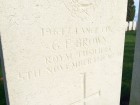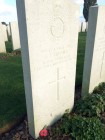George Fawcett Brown
View George Fawcett on the Commonwealth War Graves Commission website
Known information
Lance Corporal George Fawcett Brown died less than a week before the Armistice when he was shot dead near Mons. He was the son of George Brown of Caldecott and from a family who have farmed in the village for more than three hundred years. George was born on 10 August 1897, educated at Market Harborough Grammar School, and joined the staff of Barclays Branch Bank at Kettering aged 16. As soon as he turned 18 in September 1915, he enlisted in the Banker's Battalion of the 26th Royal Fusiliers, and was afterwards transferred to the 1st Battalion. He took part in a number of battles including the Somme, Messines, Amiens, Passchendaele, Cambrai, Lens, and St. Quentin. He was about to be commissioned as an officer and was expecting to come home to England when he was killed on 5 November 1918, near Mons, from a machine-gun bullet. His Commanding Officer wrote to his father: "Throughout the day your son's coolness and courage was a splendid example to all ranks, and on that day I lost one of my smartest and best men. I have had him buried in a peaceful little French orchard, where he will remain undisturbed by the ravages of war." George died just six days before the Armistice, but details of his death did not come through to Caldecott until after the war had ended, and as the villagers were celebrating victory. All bunting was taken down as a mark of respect. Below are pictures of two letters, one from a fellow soldier written after the war to George's sister telling her: "I thought you would like to know where we buried him. I, with a friend, gave him as decent a burial as circumstances would permit. His grave is in the orchard of a solitary house on the left hand side of the road as you leave St Vaaste, a rather small village....he lies next to two of our officers who were killed on the same day, 2nd Lieutenant Ball and 2nd Lieutenant Barton. We laid him to rest on Nov. 7th. I made a rough cross and put it on his grave. Trusting this information will prove comforting to you all." His body was later moved when scattered burials were brought in to form larger cemeteries. The village he was originally buried in is probably St Vaast-en-Cambrensis which is a few miles from Cross Roads Cemetery where he lies today. George's grave is II.D.8. Next to him still is Second Lieutenant Frank Hugh Barton, while in grave 4 of the same row is Second Lieutenant William Limmington Ball who was in the Northumberland Fusiliers but attached to the 1st Battalion Royal Fusiliers. The other letter shown below is a surviving one from George himself who starts by writing: "Dear Dolt and all at home" and goes on to tell them "not to whittle about me as I am in the pink and if there is a different tale to tell next week I will tell it." He signs it: "Your affectionate Brother, George." He is remembered on Caldecott's war memorial as well as on a family memorial in the churchyard.
Our thanks to Andrew Brown of Caldecott for permission to publish the letters and for other details about his great uncle.

|
Do you know something about George Fawcett that hasn't been mentioned? You can add any new information and images as a contribution at the bottom of this page. |



















.png)


.jpg)





Please wait